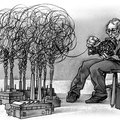
Left,Firstview; right, Fashionista.com.
Left, a dress from the Versace Spring/Summer '07 collection, which retailed for $1,685 when it was offered by Neiman Marcus this spring. On the right from Bebe, which sells their most expensive comparable dress for about $130. Forever 21 also sold a similar dress later in the summer.
Buyers from the nation’s leading department stores will sift through the work of hundreds of designers as another Fashion Week begins today in New York, seeking the looks that shoppers will want to wear next spring. Seema Anand will be looking for the ones they want right now.
Ms. Anand, who will be following the catwalk shows through photographs posted instantly on the Web, is a designer few would recognize, even though she has dressed more people than most of the famous designers exhibiting a few blocks from her garment district studio, under the tents in Bryant Park.
“If I see something on Style.com, all I have to do is e-mail the picture to my factory and say, ‘I want something similar, or a silhouette made just like this,’ ” Ms. Anand said. The factory, in Jaipur, India, can deliver stores a knockoff months before the designer version.
Ms. Anand compared a gold sequined tunic she created with a nearly identical one by the designer Tory Burch. Bloomingdale’s had asked her to make several hundred of the dresses for its private label Aqua, she said.
The Tory Burch dress sells for $750; Ms. Anand’s is $260.
Ms. Anand’s company, Simonia Fashions, is one of hundreds that make less expensive clothes inspired by other designers’ runway looks, for trendy stores like Forever 21 and retail behemoths like Macy’s and Bloomingdale’s.
A debate is raging in the American fashion industry over such designs. Copying, which has always existed in fashion, has become so pervasive in the Internet era it is now the No. 1 priority of the Council of Fashion Designers of America, which is lobbying Congress to extend copyright protection to clothing. Nine senators introduced a bill last month to support the designers. An expert working with the designers’ trade group estimates that knockoffs represent a minimum of 5 percent of the $181 billion American apparel market.
Outlawing them is certainly an uphill battle, since many shoppers see nothing wrong with knockoffs, especially as prices for designer goods skyrocket. Critics of the designers’ group even argue that copies are good for fashion because they encourage designers to continuously invent new wares to stay ahead.
Designers say that is pre-Internet thinking.
“For me, this is not simply about copying,” said Anna Sui, one of more than 20 designers who have filed lawsuits against Forever 21, one of the country’s fastest-growing clothing chains, for selling what they claim are copies of their apparel. “The issue is also timing. These copies are hitting the market before the original versions do.”
The designers seek to outlaw clothing that looks very similar to their originals but is sold under someone else’s label. They want to extend laws that already ban counterfeit handbags and sunglasses with designer logos, which reportedly account for as much as $12 billion of sales. A reliable estimate of knockoffs cannot be determined because designers and retailers disagree on which clothes are copies and which are merely “inspired” by a trend, a normal part of the fashion food chain.
Ms. Anand agreed to offer a rare look at a side of fashion that exists parallel to Seventh Avenue’s celebrity designers, though all but unknown to the public. Interviews with executives at a number of companies that specialize in designing for the private labels of department stores and other chains reveal a highly competitive network of factories, which use the latest technology to reproduce designer looks with the impunity and speed of Robin Hood. Their copies do not violate existing law.
“This is the requirement of the market,” Ms. Anand said. “If a buyer tells us, ‘This is what I need,’ we’ll make it for them. This is our business.”
Her mother, Shashi Anand, founded their company, Simonia Fashions, in 1980, five years after she moved to New York from New Delhi. Shashi Anand has won awards for her success as an Asian businesswoman, including one presented in 1998 by Bill and Hillary Clinton, whose pictures are framed on her office wall.
The company, with 10 employees in the showroom, has sales of $20 million, about 80 percent of which is for clothes sold under the private labels of stores like Bloomingdale’s and Macy’s, and for specialty chains like Forever 21, Rampage and Urban Outfitters. They also design their own line, Blue Plate.
Most of their designs are original, or partly inspired by market trends, the women said; but some look like direct copies, and some of those are made at the specific request of retailers.
At the factory in Jaipur the company contracts with 2,000 workers who specialize in pattern making, design and tailoring, and are equipped with computer programs that approximate the design of a garment from a Web image without the need to pull apart the seams.
The factory can return finished samples within 14 days. Sometimes the results are awful, “and sometimes it looks so great you’re just shocked,” Ms. Anand said. “They’ve done a better job than the designer.”
The spring collections shown this week will not arrive in stores until February, typical of the decades-old industry cycle developed when Fashion Week was a trade event. But now that the news media and the Internet disseminate runway looks instantly, fashion followers are primed to seek them out earlier. Ms. Anand’s factory can deliver her version of runway styles to stores four to six weeks after an order.
Ms. Burch, who will show her collection on Sept. 11, said she was aware that her designs had been singled out by copiers. In March, she filed a lawsuit against several stores, including the Strawberry chain, for selling ballerina flats with an insignia she thought was too close to hers. As for the sequined dress Ms. Anand made for Bloomingdale’s, similar to one of Ms. Burch’s, Frank Doroff, a senior executive vice president of the store, said he was unaware of the order.
“It is our policy not to knock off existing resources,” he said, noting that Bloomingdale’s carries the Tory Burch collection. “Does it happen sometimes? I assume it does, but that is not the way we like to do business.”
The cut or details of a garment cannot be copyrighted under existing law, although logos and original prints can be protected. Anna Sui’s suit against Forever 21, which has 400 stores and sales estimated at more than $1 billion, claims it has infringed against her prints on 26 occasions.
“It seems to be their business model to find things that are popular in the marketplace by other designers and copy them,” said Marya Lenn Yee, a lawyer for Ms. Sui.
A spokeswoman for Forever 21, Meghan Bryan, had no comment on the lawsuit. “In working with our enormous vendor base, regularly buying items from hundreds of vendors, it is extremely difficult to be certain of the origin of each item, on each and every occasion,” she said in an e-mail message.
Of several shoppers polled outside a Forever 21 branch in Herald Square in Manhattan recently, none said that knowing a design was copied would stop them from buying it.
“Some people don’t want to spend $300 on a pair of jeans just because of the name,” said Siovhan McGearey, 16, from London. “They may look nice, but why pay $300 when you can go down the street to Forever 21 and get jeans that are $30 that look exactly the same?”
Designers counter that if the knockoffs continue unabated, their businesses will be in jeopardy.
Ms. Anand maintained that her reproductions of designer styles have been changed enough that they do not violate a designer’s intellectual property. “We don’t copy anything,” she said. “We tweak it. We get inspired before we create it.”
She sees her work meeting the needs of the vast majority of consumers who cannot afford designer prices. “Especially the younger girls do not have so much money,” Ms. Anand said, “but they want to wear fashionable clothes.”
“They want to look fabulous,” she said. “It’s their right to look fabulous.”




